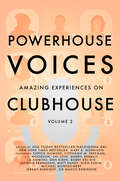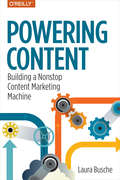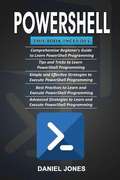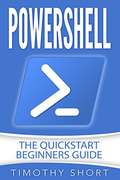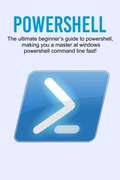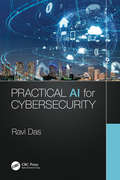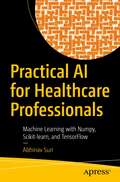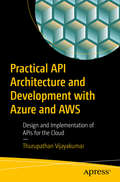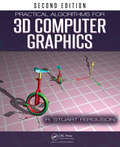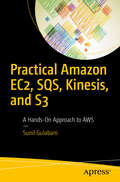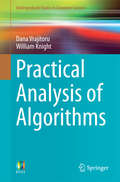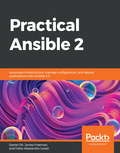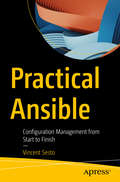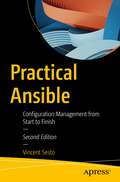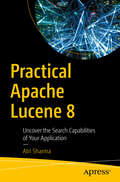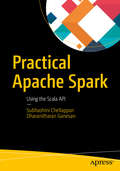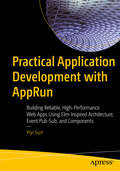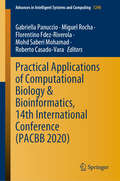- Table View
- List View
Powerhouse Voices: Amazing Experiences on Clubhouse (Volume 2)
by Naleighna Kai J. L. Woodson Mary B. Morrison Michael Montgomery Stephanie M. Freeman Ehryck Gilmore La Ammitai Darryl Benally Chi Love Matt Sandy Jacquie Branagan Glen Rudin Jeremy Burright Dan Eisen Bobby Del Rio Sir Marco RobinsonThe second book of Powerhouse Voices: Amazing Experiences on Clubhouse continues with more success stories that happened on an audio-only app that changed the world and helped people connect on a deeper level.Celebrities, influencers, life coaches, CEOs, authors, artists, and leading entrepreneurs share the best advice to level up on all platforms, expand visibility and reach, increase your client base and prosperity.Created by USA TodayBestselling Author, Naleighna KaiFeaturing Ehryck Gilmore, Stephanie M. Freeman, J. L. Woodson, Heather Tucker, Chi Love, Jacquie Branagan, Matt Sandy, Glen Rudin, and more to come.
Powering Content: Building a Nonstop Content Marketing Machine
by Laura BuscheYour new product is ready to launch and you’re itching to tell potential customers all about it. But how do you make your message stand out above all the noise and marketing clutter? Take the guesswork out of content management with this hands-on guide. You’ll learn how to produce and manage powerful content pieces that speak directly to customers and compel them to respond.Author Laura Busche walks you through content strategies and tactics drawn from business, design, and psychology insights. Packed with examples and exercises, this book teaches you how to tell your story with engaging copy, potent images, and striking design—all carefully orchestrated through well-oiled production management. Solopreneurs, startups, marketing managers, and execs will learn 10 Essential Steps to Content Success, with deep dives into:Content strategy: understand your audience, choose and prioritize channels, and find your brand’s core themes, voice, and toneContent creation: craft an engaging experience with content formats and copywriting formulas and templatesContent management: organize, delegate, and supervise tasks; optimize the content production process to reuse successful patterns
Powershell Core 6.1 Cookbook: Leverage command-line shell scripting to effectively manage your enterprise environment
by Jan-Hendrik PetersThis book will be for windows administrators who want to enhance their PowerShell scripting skills to the next level. System administrators wanting to automate common to complex tasks with PowerShell scripts would benefit from this book. Prior understanding on PowerShell would be necessary.
Powershell: Comprehensive Beginner's Guide to Learn PowerShell Programming
by Daniel JonesAre you finding yourself getting frustrated because you cannot manage all of the tasks that you need to manage therefore you are getting behind and it is causing your boss to get upset? Rather than stressing out, simply learn PowerShell! PowerShell is a program that you are going to be able to use in order to manage all of the tasks that you need to be managed. When you learn how to use PowerShell, you are going to be able to efficiently manage your administrative tasks and your boss will no longer be frustrated with you! Grab this 5 Books bundle today and learn the intricacies of Powershell programming.
Powershell: The Quickstart Beginners Guide
by Timothy ShortThis book, “PowerShell: The Quickstart Beginners Guide” will teach you everything that you need to know in order to get started programming with Microsoft Windows PowerShell. If you take the time to learn and practice what you learn within this book, you will find yourself programming with PowerShell in no time! <P><P>This guide gives you instructions so you can start applying yourself and learning how to use PowerShell right from the start. All terms are broken down throughout the book so you won't be overwhelmed with any technical jargon.
Powershell: The ultimate beginner's guide to Powershell, making you a master at Windows Powershell command line fast
by Newport CraigThis book covers the topic of Windows PowerShell and will teach you all about how to use it and all of its possibilities. <P><P>Essentially, the PowerShell is a command line interface that operates within the Windows system, with the purpose of task automation and configuration management. It is a fairly intuitive system, and as you will soon realize, it doesn’t take too long to get the hang of! <P><P>Inside, you will learn how the PowerShell operates, how the associated scripting language works, the different commands you will need to know, and what kind of things are possible when using the PowerShell. <P><P>Even if you’re totally new to programming and have never used a scripting environment, at the completion of this book you should have a solid understanding of Windows PowerShell, and be ready to get started!
Practicable Learning Analytics (Advances in Analytics for Learning and Teaching)
by Olga Viberg Åke GrönlundThis book is about practicable learning analytics, that is able to become a successful part of practice, ultimately leading to improved learning and teaching. The aim of the book is to shift our perspective on learning analytics creation and implementation from that of “designing of” technology to that of “designing for” a system of practice. That is, any successful implementation of learning analytics requires a systematic approach, which the book explains through the lens of the Information Systems Artefact, constituting of the three interdependent artefacts: “technical”, “information” and “social”.The contributions of this book go beyond a consideration of particular humans such as teachers and students, and their individual activities to consider the larger systems of activity of which analytics become part of. The chapters included in this book present different cases of learning analytics implementation across countries, and the related opportunities and challenges related to generalizability of the results.The book is written for designers, students and educators of learning analytics who aim to improve learning and teaching through learning analytics.
Practical A/B Testing: Creating Experimentation-driven Products
by Leemay NasseryWhether you're a catalyst for organizational change or have the support you need to create an engineering culture that embraces A/B testing, this book will help you do it right. The step-by-step instructions will demystify the entire process, from constructing an A/B test to breaking down the decision factors to build an engineering platform. When you're ready to run the A/B test of your dreams, you'll have the perfect blueprint.With smart, tactful approaches to orchestrating A/B testing on a product, you'll quickly discover how to reap all the benefits that A/B testing has to offer - benefits that span your users, your product, and your team. Take the reins today, and be the change you want to see in your engineering and product organizations.Develop a hypothesis statement that's backed with metrics that demonstrate if your prediction for the experiment is correct. Build more inclusive products by leveraging audience segmentation strategies and ad-hoc post analysis to better understand the impact of changes on specific user groups. Determine which path is best for your team when deciding whether to go with a third-party A/B test framework or to build the A/B testing platform in-house. And finally, learn how to cultivate an experimentation-friendly culture within your team.Leverage the A/B testing methodology to demonstrate the impact of changes on a product to your users, your key business metrics, and the way your team works together. After all, if you aren't measuring the impact of the changes you make, how will you know if you're truly making improvements?
Practical AI for Cybersecurity
by Ravi DasThe world of cybersecurity and the landscape that it possesses is changing on a dynamic basis. It seems like that hardly one threat vector is launched, new variants of it are already on the way. IT Security teams in businesses and corporations are struggling daily in order to fight off any cyberthreats that they are experiencing. On top of this, they are also asked by their CIO or CISO to try to model what future Cyberattacks could potentially look like, and ways as to how the lines of defenses can be further enhanced. IT Security teams are overburdened and are struggling to find ways in order to keep up with what they are being asked to do. Trying to model the cyberthreat landscape is a very time consuming and laborious process, because it takes a lot of time to analyze datasets from many intelligence feeds. What can be done to accomplish this Herculean task? The answer lies in Artificial Intelligence (AI). With AI, an IT Security team can model what the future Cyberthreat landscape could potentially look like in just a matter of minutes. As a result, this gives valuable time for them not only to fight off the threats that they are facing, but to also come up with solutions for the variants that will come out later. Practical AI for Cybersecurity explores the ways and methods as to how AI can be used in cybersecurity, with an emphasis upon its subcomponents of machine learning, computer vision, and neural networks. The book shows how AI can be used to help automate the routine and ordinary tasks that are encountered by both penetration testing and threat hunting teams. The result is that security professionals can spend more time finding and discovering unknown vulnerabilities and weaknesses that their systems are facing, as well as be able to come up with solid recommendations as to how the systems can be patched up quickly.
Practical AI for Healthcare Professionals: Machine Learning with Numpy, Scikit-learn, and TensorFlow
by Abhinav SuriPractical AI for Healthcare Professionals Artificial Intelligence (AI) is a buzzword in the healthcare sphere today. However, notions of what AI actually is and how it works are often not discussed. Furthermore, information on AI implementation is often tailored towards seasoned programmers rather than the healthcare professional/beginner coder. This book gives an introduction to practical AI in the medical sphere, focusing on real-life clinical problems, how to solve them with actual code, and how to evaluate the efficacy of those solutions. You’ll start by learning how to diagnose problems as ones that can and cannot be solved with AI. You’ll then learn the basics of computer science algorithms, neural networks, and when each should be applied. Then you’ll tackle the essential parts of basic Python programming relevant to data processing and making AI programs. The Tensorflow/Keras library along with Numpy and Scikit-Learn are covered as well. Once you’ve mastered those basic computer science and programming concepts, you can dive into projects with code, implementation details, and explanations. These projects give you the chance to explore using machine learning algorithms for issues such as predicting the probability of hospital admission from emergency room triage and patient demographic data. We will then use deep learning to determine whether patients have pneumonia using chest X-Ray images. The topics covered in this book not only encompass areas of the medical field where AI is already playing a major role, but also are engineered to cover as much as possible of AI that is relevant to medical diagnostics. Along the way, readers can expect to learn data processing, how to conceptualize problems that can be solved by AI, and how to program solutions to those problems. Physicians and other healthcare professionals who can master these skills will be able to lead AI-based research and diagnostic tool development, ultimately benefiting countless patients.
Practical AI on the Google Cloud Platform: Utilizing Google's State-of-the-art Ai Cloud Services
by Micheal LanhamWorking with AI is complicated and expensive for many developers. That's why cloud providers have stepped in to make it easier, offering free (or affordable) state-of-the-art models and training tools to get you started. With this book, you'll learn how to use Google's AI-powered cloud services to do everything from creating a chatbot to analyzing text, images, and video.Author Micheal Lanham demonstrates methods for building and training models step-by-step and shows you how to expand your models to accomplish increasingly complex tasks. If you have a good grasp of math and the Python language, you'll quickly get up to speed with Google Cloud Platform, whether you want to build an AI assistant or a simple business AI application.Learn key concepts for data science, machine learning, and deep learningExplore tools like Video AI and AutoML TablesBuild a simple language processor using deep learning systemsPerform image recognition using CNNs, transfer learning, and GANsUse Google's Dialogflow to create chatbots and conversational AIAnalyze video with automatic video indexing, face detection, and TensorFlow HubBuild a complete working AI agent application
Practical API Architecture and Development with Azure and AWS: Design and Implementation of APIs for the Cloud
by Thurupathan VijayakumarLearn the business and technical importance of API design and architecture using the available cloud services from Azure and AWS.This book starts off with an introduction to APIs and the concept of API Economy from a business and organizational perspective. You'll decide on a sustainable API strategy and API architecture based on different case scenarios. You'll then look at actual examples on API development guidelines, providing a practical view and approach towards the API development and aligning teams in API development. This book walks you through the API gateway services available in Azure and AWS and reviews different approaches to API Security. This will prepare you for understanding the trade-off between security and the frictionless API experience. What You'll LearnImplement API Gateways to streamline API DevelopmentExamine Security Mapping with API gateways from Azure and AWSApply API implementation using Serverless architectureReview evolving APIs for monitoring and changing business requirementsUse code samples in API security implementations Who This Book Is ForDevelopers and architects with .NET and web development experience who want to learn about API design.
Practical ASP.NET Web API
by Badrinarayanan LakshmiraghavanPractical ASP. NET Web API provides you with a hands-on and code-focused demonstration of the ASP. NET Web API in action. From the very beginning, you'll be writing working code in order to see best practices and concepts in action. As the book progresses, the concepts and code will become more sophisticated. Beginning with an overview of the web service model in general and Web API in particular, you'll progress quickly to a detailed exploration of the request binding and response formatting that lie at the heart of Web API. You'll investigate various scenarios and see how they can be manipulated to achieve the results you need. Later in the book more sophisticated themes will be introduced that will set your applications apart from the crowd. You'll learn how you can validate the request messages on arrival, how you can create loosely coupled controllers, extend the pipeline processing to compartmentalize your code for security and unit testing before being put onto a live hosting server. What you'll learn What ASP. NET Web API is and how it can be used effectively Ways to optimize your code for readability and performance What controller dependencies are and why they matter How to maintain robust security across your projects Reliable best-practices for using Web API in a professional context Who this book is for The book is ideal for any . NET developer who wants to learn how the ASP. NET Web API framework works in a realistic setting. A good working knowledge of C# and the . NET framework and a familiarity with Visual Studio are the only pre-requisites to benefit from this book Table of Contents Building a Basic Web API Debugging HTTP Formatting CLR Objects into HTTP Response Customizing Response Binding HTTP Request into CLR Objects Validating Request Managing Controller Dependencies Extending Pipeline Hosting ASP. NET Web API Securing ASP. NET Web API Consuming ASP. NET Web API Building Performant Web API
Practical AWS Networking: Build and manage complex networks using services such as Amazon VPC, Elastic Load Balancing, Direct Connect, and Amazon Route 53
by Mitesh Soni Zoltan Altfatter Adrin MukherjeeKey Features Master your networking skills on Public Cloud. Gain hands-on experience of using Amazon VPC, Elastic Load Balancing, Direct Connect and other AWS products. Implement troubleshooting skills and best practices for security on AWS network. Book Description Amazon Web Services (AWS) dominates the public cloud market by a huge margin and it continues to be the first choice for many organizations. Networking has been an area of focus for all the leading cloud service providers. AWS has a suite of network-related products that help to perform network-related task in AWS. This book initially covers the basics of networking in AWS. Then we use AWS VPC to create an isolated virtual cloud for performing network-related tasks. We then provide an overview of AWS Direct Connect after taking a deep dive into scalability and load balancing using Auto scaling feature, Elastic Load Balancing, and Amazon Route S3. Toward the end of the book, we cover some troubleshooting tips and security best practices for your network. By the end of this book, you will have hands-on experience of working with network tasks on AWS. What you will learn Overview of all networking services available in AWS. Gain Work with load balance application across different regions. Learn auto scale instance based on the increase and decrease of the traffic. Deploy application in highly available and fault tolerant manner. Configure Route 53 for a web application. Troubleshooting tips and best practices at the end
Practical Algorithms for 3D Computer Graphics
by R. Stuart FergusonPractical Algorithms for 3D Computer Graphics, Second Edition covers the fundamental algorithms that are the core of all 3D computer graphics software packages. Using Core OpenGL and OpenGL ES, the book enables you to create a complete suite of programs for 3D computer animation, modeling, and image synthesis.Since the publication of the first edit
Practical Amazon EC2, SQS, Kinesis, and S3
by Sunil GulabaniProvide solutions to all your Amazon EC2, SQS, Kinesis, and S3 problems, including implementation using the AWS Management Console, AWS CLI, and AWS SDK (Java). You'll find recipes on implementation and configuration of Amazon EC2, SQS, Kinesis, and S3 along with the code snippets and AWS CLI commands. Practical Amazon EC2, SQS, Kinesis, and S3 uses focused examples that include only the details you need to get things done. You'll see production use cases of Amazon EC2, SQS, Kinesis, and S3 and how to implement cloud watch in projects for these services. Learn how to raise an alarm on Amazon EC2, SQS, Kinesis, and S3 as part of a continuous monitoring system designed to increase performance and avoid side effects in your services. What You'll Learn Manage Amazon EC2, SQS, Kinesis, and S3 using the AWS Management Console Use the AWS CLI Employ the AWS Java SDK Configure alarms on Amazon EC2, SQS, Kinesis, and S3 Who This Book Is For Software developers and architects, system engineers, and project managers
Practical Analysis of Algorithms
by Dana Vrajitoru William KnightThis book introduces the essential concepts of algorithm analysis required by core undergraduate and graduate computer science courses, in addition to providing a review of the fundamental mathematical notions necessary to understand these concepts. Features: includes numerous fully-worked examples and step-by-step proofs, assuming no strong mathematical background; describes the foundation of the analysis of algorithms theory in terms of the big-Oh, Omega, and Theta notations; examines recurrence relations; discusses the concepts of basic operation, traditional loop counting, and best case and worst case complexities; reviews various algorithms of a probabilistic nature, and uses elements of probability theory to compute the average complexity of algorithms such as Quicksort; introduces a variety of classical finite graph algorithms, together with an analysis of their complexity; provides an appendix on probability theory, reviewing the major definitions and theorems used in the book.
Practical Ansible 2: Automate infrastructure, manage configuration, and deploy applications with Ansible 2.9
by James Freeman Fabio Alessandro Locati Daniel OhLeverage the power of Ansible to gain complete control over your systems and automate application deployment Key Features Use Ansible 2.9 to automate and control your infrastructure Delve into advanced functionality such as plugins and custom modules in Ansible Automate and orchestrate major cloud platforms such as OpenStack, AWS, and Azure using Ansible Book Description Ansible enables you to automate software provisioning, configuration management, and application roll-outs, and can be used as a deployment and orchestration tool. While Ansible provides simple yet powerful features to automate multi-layer environments using agentless communication, it can also solve other critical IT challenges, such as ensuring continuous integration and continuous deployment (CI/CD) with zero downtime. In this book, you'll work with Ansible 2.9 and learn to solve complex issues quickly with the help of task-oriented scenarios. You'll start by installing and configuring Ansible on Linux and macOS to automate monotonous and repetitive IT tasks and get to grips with concepts such as playbooks, inventories, and network modules. As you progress, you'll gain insight into the YAML syntax and learn how to port between Ansible versions. In addition to this, you'll also understand how Ansible enables you to orchestrate multi-layer environments such as networks, containers, and the cloud. By the end of this Ansible book, you'll be well - versed in writing playbooks and other related Ansible code to overcome just about all of your IT challenges, from infrastructure-as-code provisioning to application deployments, and even handling the mundane day-to-day maintenance tasks that take up so much valuable time. What you will learn Become familiar with the fundamentals of the Ansible framework Set up role-based variables and dependencies Avoid common mistakes and pitfalls when writing automation code in Ansible Extend Ansible by developing your own modules and plugins Contribute to the Ansible project by submitting your own code Follow best practices for working with cloud environment inventories Troubleshoot issues triggered during Ansible playbook runs Who this book is for If you are a DevOps engineer, administrator, or any IT professional looking to automate IT tasks using Ansible, this book is for you. Prior knowledge of Ansible is not necessary.
Practical Ansible: Configuration Management from Start to Finish
by Vincent SestoGo from the basics of using Ansible to becoming proficient at implementing configuration management in your projects. This book uses a unique approach to teaching Ansible and configuration management while including realistic examples in its day-to-day use from server-based infrastructure to Amazon cloud-based deployments. Practical Ansible is separated into seven chapters that allow you to build your knowledge with each chapter, developing further as we move through the examples provided. It begins with the basics of Ansible, providing you with details on how to install and configure your environment while working with different Ansible modules from the command line. Next, it introduces you to working with Ansible tasks and organizing configuration code into playbooks. The book then shows you how to extend playbooks further, using roles and templates within the configuration code. Then, it extends your knowledge further by covering custom Ansible modules using Python and Linux shell scripts, and demonstrating how you can start to keep your secret values encrypted and secure using Ansible Vault. You’ll also extend Ansible roles with the use of Ansible Galaxy to reuse existing roles other users have created. The second half of the book moves configuration management to the Amazon cloud providing an introduction on what Amazon Web Services are, and how you can start to work with Ansible roles in AWS. The AWS examples use EC2 and CloudFormation services with Ansible template functions, Ansible Pull, and Ansible Git code deployment. The final part of the book includes a demonstration on how to use the numerous tools available to both Ansible and supporting libraries and modules to allow you to troubleshoot and test your configuration code before you deploy your changes to production systems. By the end of this book, you will have the skills for managing technology configuration management. You will be ready to work on real-world projects and be able to implement Ansible in your own technology projects. What You Will Learn Understand the basics of Ansible and how to install and configure the application on your systemMake changes to your system using Ansible directly in the command line using some of the more common Ansible modulesGroup your modules together as tasks in Ansible playbooks for more efficient deployment of configuration changesUse Ansible roles to help group and reuse configuration management changes and deploymentsSearch for community-created roles using Ansible Galaxy and how you can also host your own Ansible roles Deploy code to Amazon Web Services and how to utilize different AWS services in your deployment projectsUse external modules and libraries such as Molecule and Ansible Lint to help test your configurations before the configuration code is deployed Who This Book Is For System administrators, DevOps engineers, software engineers, and developers wanting to extend their current knowledge of computer systems and incorporate Ansible as a configuration management tool within them.
Practical Ansible: Configuration Management from Start to Finish
by Vincent SestoGet ready to go from the basics of using Ansible to becoming proficient at implementing configuration management in your projects. This book begins with the basics of Ansible, providing you with details on how to install and configure your environment while working with different Ansible modules from the command line. Next, it introduces you to working with Ansible tasks and organizing configuration code into playbooks. You’ll then learn how to extend playbooks further, using roles and templates within the configuration code. Author Vincent Sesto then extends your knowledge further by covering custom Ansible modules using Python and Linux shell scripts and demonstrating how you can start to keep your secret values encrypted and secure using Ansible Vault. You’ll also develop Ansible roles with the use of Ansible Galaxy to reuse existing roles that others have created.This updated edition reflects changes added in the latest version of Ansible (2.9). It also includes an expanded chapter on testing Ansible using Molecule and managing large server environments using applications like Ansible Tower.What Will You LearnUnderstand what Ansible is and how to install and run your first basic command line commandsExpand your configuration management using Ansible playbooks, roles and templatesCustomize your code further using Ansible Vault and third-party roles in Ansible Galaxy.Work with Ansible in managing cloud infrastructure, specifically in Amazon Web ServicesTroubleshoot your Ansible code and use frameworks like Molecule and Testinfra to help test your code changesManage large server environments using real-world examples and extend your configurations using an application like Ansible TowerWho This Book Is For Systems Engineers, Developers, DevOps Engineers and Software Administrators.
Practical Apache Lucene 8: Uncover the Search Capabilities of Your Application
by Atri SharmaGain a thorough knowledge of Lucene's capabilities and use it to develop your own search applications. This book explores the Java-based, high-performance text search engine library used to build search capabilities in your applications. Starting with the basics of Lucene and searching, you will learn about the types of queries used in it and also take a look at scoring models. Applying this basic knowledge, you will develop a hello world app using basic Lucene queries and explore functions like scoring and document level boosting. Along the way you will also uncover the concepts of partial searching and matching in Lucene and then learn how to integrate geographical information (geospatial data) in Lucene using spatial queries and n-dimensional indexing. This will prepare you to build a location-aware search engine with a representative data set that allows location constraints to be specified during a search. You’ll also develop a text classifier using Lucene and Apache Mahout, a popular machine learning framework. After a detailed review of performance bench-marking and common issues associated with it, you’ll learn some of the best practices of tuning the performance of your application. By the end of the book you’ll be able to build your first Lucene patch, where you will not only write your patch, but also test it and ensure it adheres to community coding standards.What You’ll Learn Master the basics of Apache LuceneUtilize different query types in Apache LuceneExplore scoring and document level boostingIntegrate geospatial data into your application Who This Book Is ForDevelopers wanting to learn the finer details of Apache Lucene by developing a series of projects with it.
Practical Apache Spark: Using the Scala API
by Subhashini Chellappan Dharanitharan GanesanWork with Apache Spark using Scala to deploy and set up single-node, multi-node, and high-availability clusters. This book discusses various components of Spark such as Spark Core, DataFrames, Datasets and SQL, Spark Streaming, Spark MLib, and R on Spark with the help of practical code snippets for each topic. Practical Apache Spark also covers the integration of Apache Spark with Kafka with examples. You’ll follow a learn-to-do-by-yourself approach to learning – learn the concepts, practice the code snippets in Scala, and complete the assignments given to get an overall exposure. On completion, you’ll have knowledge of the functional programming aspects of Scala, and hands-on expertise in various Spark components. You’ll also become familiar with machine learning algorithms with real-time usage.What You Will LearnDiscover the functional programming features of ScalaUnderstand the complete architecture of Spark and its componentsIntegrate Apache Spark with Hive and Kafka Use Spark SQL, DataFrames, and Datasets to process data using traditional SQL queriesWork with different machine learning concepts and libraries using Spark's MLlib packagesWho This Book Is ForDevelopers and professionals who deal with batch and stream data processing.
Practical App Development with Aurelia: Leverage The Power Of Aurelia To Build Personal And Business Applications
by Matthew DuffieldExplore all the aspects of the Aurelia framework, including routing, templating, data binding, custom elements, event aggregation, HTTP services, features, plugins, etc. You’ll see how to tie all the pieces together and walk away with an understanding of how to build applications, end to end.Practical App Development with Aurelia teaches you to write a line of business applications using simple, clean JavaScript harnessing the Aurelia framework. You’ll learn the key abstractions of Aurelia and understand the life cycle of components. If you want to understand the key features of the framework and gain a mastery of building Aurelia apps, then this is the book for you.Aurelia is a modern front-end framework for mobile, desktop, and web clients. It is standards-based meaning that it has a very low learning curve. This book highlights the framework’s simplicity and its power. What You'll LearnCreate routes and implement pipelinesUtiliize dependency injection in your classesCommunicate loosely-coupled across all viewsDeploy your solution with minimal effortWho This Book Is ForDevelopers, Practitioners, Programmers, and Managers who want to understand how to fundamentally create Web applications using Aurelia.
Practical Application Development with AppRun: Building Reliable, High-Performance Web Apps Using Elm-Inspired Architecture, Event Pub-Sub, and Components
by Yiyi SunExplore the concepts, patterns, and architecture behind AppRun applications. With this end-to-end guide, you will be able to build web apps fast to the market with the low learning curve and high development productivity. You will learn how to break down the application logic into three decoupled parts: state, view, and update. You will then see how to connect web page events to the AppRun event life-cycle, route user interactions, access data from the remote servers, compose the user interface using components, and integrate 3rd party libraries. Following examples of various apps, such as the counter app, to-do app, weather app, hacker news reader app, and blog app, you will have all the techniques for developing your AppRun apps including the line of business apps. You will also review wider development concepts such as using strongly typed states practically, unit testing strategies for app state changes, time travel debugging, async web API invocation, server-side virtual DOM, module compilation optimization, the developer tools, and more.What You'll LearnUse AppRun to develop web apps end-to-endUnderstand the technology behind AppRunEvaluate and compare architecture designDevelop applications using Elm architecture, event publication and subscription, and components. Who This Book Is For Web app developers and architects; useful for beginners learning front-end development and more experienced developers interested in learning about AppRun and modern development concepts and principles more generally
Practical Applications of Computational Biology & Bioinformatics, 14th International Conference (Advances in Intelligent Systems and Computing #1240)
by Florentino Fdez-Riverola Mohd Saberi Mohamad Miguel Rocha Gabriella Panuccio Roberto Casado-VaraThis book highlights the latest research on practical applications of computational biology and bioinformatics, and addresses emerging experimental and sequencing techniques that are posing new challenges for bioinformatics and computational biology. Successfully applying these techniques calls for new algorithms and approaches from fields such as statistics, data mining, machine learning, optimization, computer science, and artificial intelligence. In response to these challenges, we have seen the rise of a new generation of interdisciplinary scientists with a strong background in the biological and computational sciences.These proceedings include 21 papers covering many different subfields of bioinformatics and computational biology. Focusing on interdisciplinary applications that combine e.g. bioinformatics, chemoinformatics, and system biology, they are intended to promote the collaboration of scientists from different research groups and with different backgrounds (computer scientists, mathematicians, biologists) to reach breakthrough solutions and overcome the challenges outlined above.
